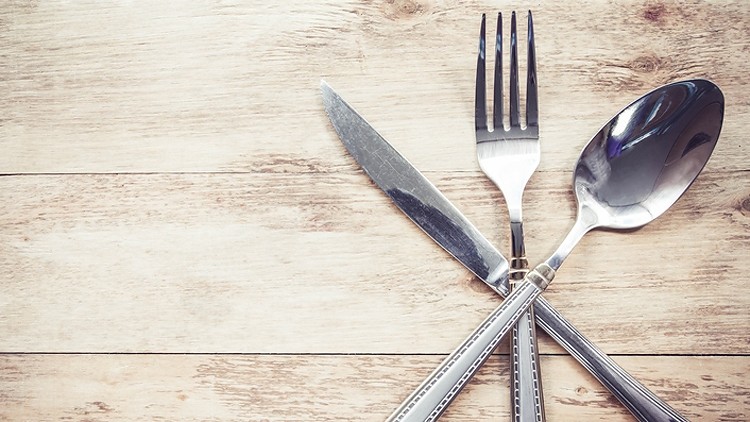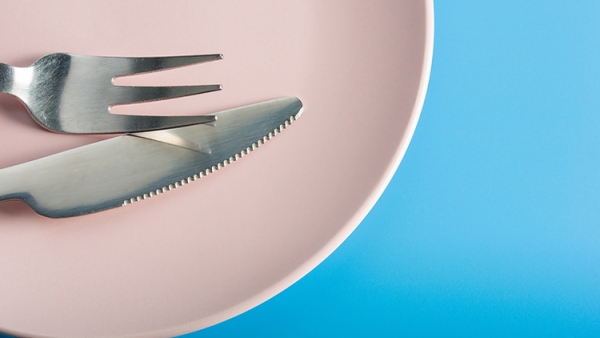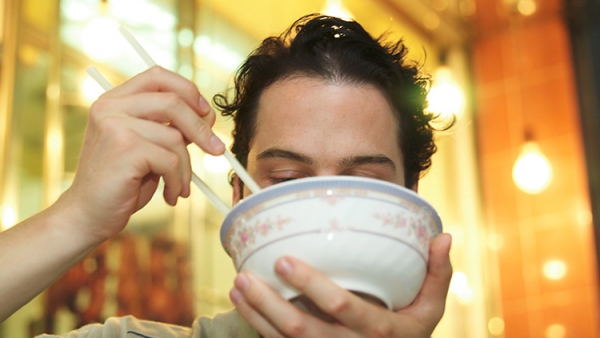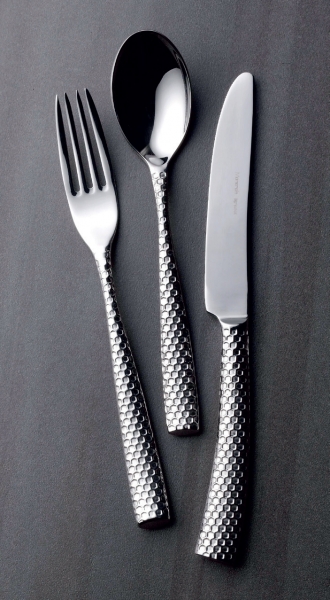The A-Z of cutlery

Asia
The Far East shook up the cutlery market in the ’90s, bringing much more choice and dramatically lowering prices. “The single biggest change since we started 30 or so years ago is Asia entering the market,” says Parsley in Time owner Ted Walpole. “This has flooded the UK with high-quality, affordable tableware. We source ours mainly from Korea but the stuff coming from China is pretty good too.”
Buffing
Cutlery is buffed after it has been worked into shape. Entry-level cutlery will receive a tumble finish, the cheapest available, while economy level cutlery will go through four levels of buffing. The finest 18/10 cutlery can receive up to 27 levels of buffing, including buffing between the prongs of forks, for a silky smooth finish.
Coated cutlery
Powder-coated cutlery – with finishes including copper, titanium and black – have risen considerably in popularity over the past few years. Nisbets reports a huge rise in the sales of such ranges. Other coating methods include galvanisation, in which the cutlery is coated in a fine layer of gold or silver.
Dishwashers
Traditionally the enemy of cutlery, modern dishwashers are designed to be kinder to flatware. The one exception to this is wooden handles, which will be ruined by dishwashers unless the wood has been impregnated with a polymer.
Effects
Nostalgia and the practice of sourcing second-hand items for restaurant tables has seen the popularity of faux bone-effect handle cutlery rise. Renewed interest in this old-fashioned cutlery style has led to companies starting to manufacture it again using robust polymer handles, including Sheffield’s Chimo Holdings.
Forged cutlery
Forged cutlery begins life as solid bars and is pounded into shape, allowing for the production of round, oval and square designs. Due to the labour needed to create this cutlery, it is usually more expensive than stamped cutlery (see S).
Gentle handling
It’s important to be gentle with quality cutlery. 18/10 will scratch if handled roughly. Allowing kitchen porters to scoop up big handfuls of cutlery and ram them into warewasher baskets is a particularly poor idea.
Hollow handles
Counter intuitively, hollow-handled cutlery is more expensive to make than solid-handled cutlery. “The manufacturing process is far more complicated,” says Ross Jones, brand manager for Chinacraft at Nisbets.
“To make hollow-handled cutlery, you need to mould both sides of the handle and seal them together over the blade to create a seamless effect. Solid handled cutlery is simply fashioned from one lump of metal.”
Inox
Another term for stainless steel that’s sometimes used in cutlery marketing (see T).
Joints
In most cases, cutlery with obvious joints won’t last as long as fully sealed cutlery. The one exception to this is riveted-style steak knives, which will wear well.
Korea
When eating in Korea or a traditionally run Korean restaurant, don’t fall foul of the country’s strict cutlery etiquette. Never put chopsticks in food standing up, particularly rice, as this is believed to bring bad luck since it resembles the food left at graves to sustain deceased ancestors.
Lustre
Good-quality 18/10 and 18/8 will fade over time but it is likely to outlive most restaurants with a lifespan of decades rather than years. “It will be lost in the bin long before it becomes unusable,” says Artis marketing manager Gill Head. Lesser quality 18/0 steel loses its lustre much faster than 18/10 and 18/8.
Magnetic
A big advantage for casual, high-volume establishments is that 18/0 steel is magnetic, which allows them to fit powerful magnets to bins to reduce the number of pieces accidentally thrown out by kitchen porters.
Nickel
A component of high-quality stainless steel, nickel makes the metal more malleable during the construction process. Its high cost is the reason why 18/10 is so expensive.
Odd cutlery
You’ve probably heard of sporks, but what about trongs (plastic finger protectors designed to keep your fingers clean when eating ribs and the like), the sporf (a spork that incorporates a knife edge) and the chork (chopsticks that double as forks)? Novelty cutlery might not be suitable for every restaurant, but it can create a talking point at the table – and on Instagram.
Parish styles
Most cutlery used in restaurants is either plain with no pattern on the handle or based on one of several traditional ‘parish styles’, including rat tail (a line down the middle of the handle), bead (a beaded effect around the edge of the handle) and Grecian (an embossed effect).
Quality
The quality of cutlery varies dramatically. The highest quality 18/10 pieces sell for upwards of a fiver while single pieces of 18/0 cutlery can be bought from as little as 50p, although they are not likely to last long and will tarnish more easily. This cheaper cutlery is typically the default choice of more casual restaurants and tends to be replaced more regularly than 18/10 and 18/8. Quality varies considerably, with products from reputable manufacturers likely to last considerably longer than those that are not.
Residual
Lower grade cutlery can damage plates – a lot of the ‘scratches’ you see on plates are actually marks left by the cutlery, known in the business as cutlery residual. Generally, if you’re using 18/10, this won’t happen.
Stamped cutlery
More affordable than the forged variety, stamped cutlery starts life as one massive sheet of stainless steel from which it is stamped. This method allows for the creation of a wide variety of patterns on the cutlery, although the stamping process means that it has to have a relatively flat design.
Ten
The number 10 in cutlery descriptions refers to the 10% nickel content of a piece of stainless steel cutlery and is always preceded by the number 18, which refers to its 18% chromium content. The highest quality of steels available are 18/10 and 18/8. Both are generally considered to have the optimal amounts of chromium and nickel for tableware. If numbers are not offered, the chances are it’s 18/0 steel, which is more prone to bending than 18/10 and 18/8.
Unique
Unlike with crockery, where chefs often commission an artist to create one-off plates for specific dishes, cutlery styles are typically made in bulk. That doesn’t mean truly unique cutlery doesn’t exist. Designer Luki Huber created a number of utensils exclusively for Ferran Adria’s El Bulli in Spain when it was open, including the spoon with clip, which allows diners to smell the aroma of one thing such as an herb or flower clipped to the spoon while tasting another thing. And Harry White Design has created evo-cut cutlery, a one-off set designed according to the principles of population genetics and natural variation. Rather than just having two sizes, this set of cutlery shows continuous variation in size and shape. It is now the property of Central Saint Martins School of Art and Design in King’s Cross and is occasionally on display.
Vintage effect
Cutlery can be stone-washed to create a matte, vintage effect on the stainless steel, a method that often results in the creation of non-uniform items. “Stone-washed cutlery has been a game-changer,” says Nisbets’ Jones. “We’re selling a huge amount of it to a wide range of clients.” To some extent, the trend for stone-washed cutlery is linked to the movement for restaurants and bars using more rustic tableware and for using vintage items, such as soda syphons and glassware. “It looks really good alongside tableware and food that has a naturalistic look and feel,” adds Jones. Stone-washed cutlery is usually a comparable price to good quality 18/10.
Weight
In contrast to most other western markets, the UK equates weight with quality (see H). Professor Charles Spence, an experimental psychologist at the University of Oxford, recently conducted an experiment that showed the cutlery given to diners in a restaurant can have a big impact on their perception of a given dish and a meal more generally. Participants in the trial were served the same dish but with different weights of cutlery; the heavier the knives and forks they used, the more expensive they thought the dish should be.
Generation X
Restaurants that appeal mainly to the Generation X demographic of diners (born roughly between 1960 and 1980) should consider using silverware (although see Z). Silver is the most expensive material used in tableware, but it has a strong association with quality for people in this age group. Silver cutlery is almost always plated but some of the world’s priciest restaurants and hotels – typically frequented by Generation X diners rather than Millennials – opt for pieces hewn from solid pieces of silver.
Younger diners
Having cutlery suitable for little diners is a must, and your choice should reflect your restaurant. Brands such as Robert Welch offer a large range of kids cutlery in traditional and sophisticated styles but, for early eaters, you might want to choose more colourful items. Artis’ brightly coloured Monster children’s cutlery features easy-to-grip polyester handles in purple, orange and green, and feature different monster images, that have been ergonomically shaped for smaller hands.
Zoe Laughlin
The University College London researcher believes restaurants should think twice about using silver cutlery because it can taint certain foods. “It is not very pleasant at all,” she says. “It tastes metallic and it also reacts badly with the acid in fruit and the sulphur in eggs.”

























